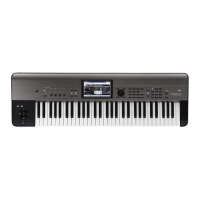PROG P6: AMS/Common Key Track (AMS Mixer/Common Keyboard Track) 6–2: OSC1 AMS Mix2
51
6–2: OSC1 AMS Mix2
This is the second AMS Mixer for Oscillator 1. The
parameters are exactly the same as those for AMS Mixer 1,
as described under “6–1a: AMS Mixer 1” on page 46.
6–4: OSC 2 AMS Mix1 ,
6–5: OSC 2 AMS Mix2
This page controls the two AMS Mixers for Oscillator 2.
These are available only when the Oscillator Mode is set to
Double or Double Drums; if not, the page will be grayed
out.
The parameters are identical to those for Oscillator 1, as
described under “6–1: OSC1 AMS Mix1” on page 46.
6–9: Common KeyTrk 1
(Common Keyboard Track 1)
The two Oscillators share two Common keyboard tracking
generators, in addition to each Oscillator’s dedicated
keyboard tracking for the Filter and Amp. You can use these
Common keytracks as AMS sources for modulating most
AMS destinations.
The Common Keyboard Track parameters are shared by the
entire Program, but the actual AMS values are calculated
individually for each voice.
What does Keyboard Tracking do?
At its most basic, keyboard tracking lets you vary the
modulation amount as you play up and down the keyboard.
This can be useful for making the timbre consistent across
the entire range, or adjusting parameters according to pitch.
The KROME keyboard tracking can be fairly complex, if
desired. You can create different rates of change over up to
four different parts of the keyboard. For instance, you can:
• Make the modulation increase very quickly over the
middle of the keyboard, and then increase more slowly or
not at all in the higher octaves.
• Make the modulation increase as you play lower on the
keyboard.
• Create abrupt changes at certain keys, for split‐like effects.
Common Keyboard Tracking
For more information, please see “3–2: Filter1 Keyboard
Track” on page 28.
6–9a
6–9
Menu
Low Break Center High Break
+99
+50
00
–50
–99
Ramp:
+99
+99
–99
0
–99
Ramp:
AMS
AMS
Ramp = +99
Ramp = –50
At the Center Key, the AMS value is always 0.

